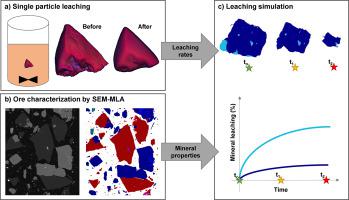Hydrometallurgy ( IF 4.8 ) Pub Date : 2022-04-04 , DOI: 10.1016/j.hydromet.2022.105869 Chandra Widyananda Winardhi 1 , Jose Ricardo da Assuncao Godinho 1 , Cindytami Rachmawati 1 , Isabelle Duhamel Achin 2 , Ainhoa Unzurrunzaga Iturbe 3 , Gero Frisch 4 , Jens Gutzmer 1

|
Encouraged by the need for ecologically and economically sustainable technologies for the recovery of metals from complex raw materials, ionometallurgical leaching using deep eutectic solvents is emerging as a promising alternative to conventional hydro- and pyrometallurgical process routes. Current approaches of studying leaching processes do not provide a mineral-based understanding of the leaching process – thus limiting the opportunities for process optimization. This study addresses this shortcoming by combining laboratory-based X-ray computed tomography (CT) and scanning electron microscopy-based image analysis. The latter method provides precise information on the mineralogy and texture of the leach feed material, whereas CT is used to observe the progress of the leaching process through time. Leaching of Au Ag bearing sulfide flotation concentrate by the deep eutectic solvent ethaline with iodine as oxidizing agent is used as a relevant case study. Results show that time-lapse CT provides an accurate estimation of the dissolution rate of pyrite, chalcopyrite, galena, telluride minerals and gold. Dissolution rates were used to simulate the metal recoveries from the sulfide concentrate as a function of leaching time. Simulation results are within 5% variation of metal recoveries obtained by batch leaching experiments. The developed workflow can be easily transferred to other ore types or mineral concentrates; results may be used to study and optimize industrial leaching processes.
Ag bearing sulfide flotation concentrate by the deep eutectic solvent ethaline with iodine as oxidizing agent is used as a relevant case study. Results show that time-lapse CT provides an accurate estimation of the dissolution rate of pyrite, chalcopyrite, galena, telluride minerals and gold. Dissolution rates were used to simulate the metal recoveries from the sulfide concentrate as a function of leaching time. Simulation results are within 5% variation of metal recoveries obtained by batch leaching experiments. The developed workflow can be easily transferred to other ore types or mineral concentrates; results may be used to study and optimize industrial leaching processes.
中文翻译:

一种基于粒子的方法来预测使用乙醇的浸出过程的成功和选择性 - 模拟和实验结果的比较
受到从复杂原材料中回收金属的生态和经济可持续技术的需求的鼓舞,使用深共熔溶剂的离子冶金浸出正在成为传统水法和火法冶金工艺路线的有希望的替代方案。目前研究浸出过程的方法不能提供对浸出过程的基于矿物的理解,从而限制了过程优化的机会。本研究通过结合基于实验室的 X 射线计算机断层扫描 (CT) 和基于扫描电子显微镜的图像分析来解决这一缺点。后一种方法提供了有关浸出进料的矿物学和质地的精确信息,而 CT 用于观察浸出过程随时间的进展。Au的浸出 以碘为氧化剂的深共熔溶剂乙炔浮选含银硫化物精矿作为相关案例研究。结果表明,延时 CT 可以准确估计黄铁矿、黄铜矿、方铅矿、碲化物矿物和金的溶解速率。溶解速率被用来模拟作为浸出时间函数的硫化物精矿的金属回收率。模拟结果与批次浸出实验获得的金属回收率相差在 5% 以内。开发的工作流程可以很容易地转移到其他矿石类型或精矿;结果可用于研究和优化工业浸出过程。
以碘为氧化剂的深共熔溶剂乙炔浮选含银硫化物精矿作为相关案例研究。结果表明,延时 CT 可以准确估计黄铁矿、黄铜矿、方铅矿、碲化物矿物和金的溶解速率。溶解速率被用来模拟作为浸出时间函数的硫化物精矿的金属回收率。模拟结果与批次浸出实验获得的金属回收率相差在 5% 以内。开发的工作流程可以很容易地转移到其他矿石类型或精矿;结果可用于研究和优化工业浸出过程。











































 京公网安备 11010802027423号
京公网安备 11010802027423号